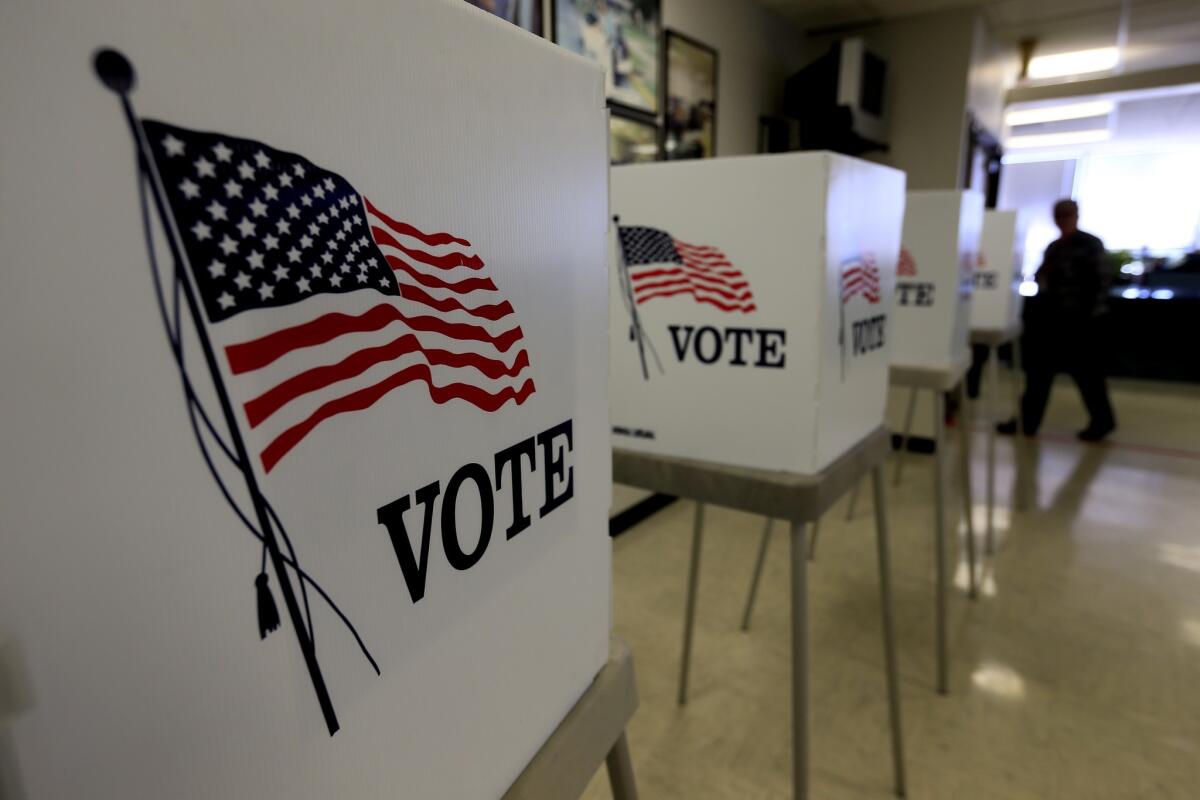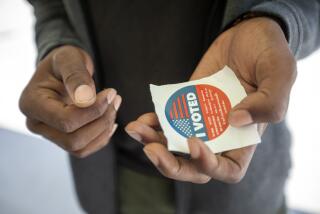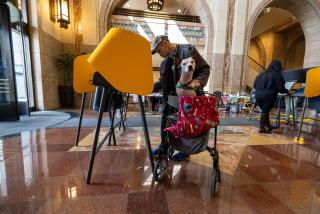Los Angeles County voters will encounter new ballot machines, other changes on Super Tuesday

- Share via
On Tuesday, California voters will formally join 14 states, one territory and the passel of Democrats living abroad in national elections.
By stepping up to Super Tuesday, the delegate-rich, donor-abundant state is taking a stab at electoral relevance, and officials are both optimistic and guarded. The chaotic and muddled results from the Iowa caucus still cast a long shadow over voter confidence.
Not since 2008 has a presidential primary fallen so early in California, but the change of date is just one of the many differences that Angelenos will encounter as they prepare to cast their ballots.
Los Angeles County officials recently completed a $300-million overhaul of the voting system, including expanding voting schedules, redesigning ballots and introducing 31,000 new machines used to mark them.
The most significant change, however, is a reduction in the number of precinct polling places from the last presidential primary, a change brought about by Los Angeles County agreeing to meet the requirements of a far-reaching state election law that swaps out neighborhood voting locations for regional “vote centers.”
Nearly 3,500 neighborhood voting locations throughout the county — familiar destinations for long-time voters — have been closed. In Long Beach, for instance, there are 33 polling locations; in the 2016 primary, there were 247. In Santa Clarita, 18 polling locations are open, as opposed to 92 four years ago.
Some voting advocates are worried that some voters might be confused by the closures and new locations.
L.A. elections officials have opened nearly 1,000 vote centers, more than were required when adopting the new state election plan. One benefit to that new plan, according to supporters, is that county residents are no longer limited to one polling place and can cast their ballots throughout the county regardless of where they live.
Voters who live in Whittier, for example, would receive their Whittier ballot even if they went to a voting center in downtown Los Angeles.
“There are no longer wrong places to vote in L.A. County,” said Dean Logan, the registrar-recorder/county clerk, who has led the ambitious overhaul of the county system. “Every voting location is the right place to vote.”
Some centers opened as early as Feb. 22, but the majority — 744 — opened their doors Saturday.
Elections officials note that given the size and scale of these openings, voters might experience delays at vote centers, and if one center is experiencing problems, they can visit another.
The Times has published an online guide to the county locations.
Voters have until March 3 to cast their ballot and are given a variety of election services. If they have not registered, they can register on site. They can switch their party designation, and they can visit a vote center to submit a mail-in ballot.
Most locations are familiar — schools, community buildings, parks and fire houses — but there are unexpected places, including the Sherman Oaks Galleria, the Hollywood Hotel, a youth center on Dockweiler Beach, a French restaurant in Santa Clarita and an auto dealership in Burbank.
The ballot machines have also changed. They are touch-pad devices with 13 language options, audio headsets for voters with disabilities and an option to increase the size of the print.
Upon signing in at a vote center, voters are given a paper ballot, keyed to their home address and the races in their city and district.
Once in the voting booth, they insert the paper ballot into the machine and register their votes on the touch screen. When completed, the ballot is ejected, allowing voters to review their selections, and when finished, voters reinsert the ballot into the machine, which transfers it to a sealed ballot box.
County officials and voting rights advocates have been working hard to avoid confusion and ensure the public understands their options. Los Angeles County has about 5.4 million registered voters, and roughly 3.4 million of them have been mailed a ballot.
More than 93,200 voters have cast their ballots, Logan said Saturday night, leaving as many as two-million voters without mail-in ballots until Tuesday at 7 p.m. More than 444,000 mail ballots have been returned.
County officials and voting rights advocates are watching closely to see how the vote centers perform. Hundreds of public meetings and presentations were organized to help familiarize voters with the new system.
Scattered complaints have arisen at a few of the early voting centers, mostly for having failed to open on time or have all of their machines up and running.
Mathew Pauley, 59, arrived at 8 a.m. last Saturday to cast his ballot inside the community room at the Sherman Oaks Mall. Poll workers were still setting up the equipment, so Pauley returned later that morning. He was confident in the new system.
“This was the first time since I was 18 that I really felt that my vote was counted,” he said. “I was surprised with the system. It was great.”
Times staff writer Matt Stiles contributed to this report.
More to Read
Sign up for Essential California
The most important California stories and recommendations in your inbox every morning.
You may occasionally receive promotional content from the Los Angeles Times.











